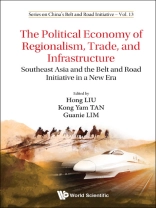Since its launch in late 2013, the Belt and Road Initiative (BRI) has become a significant factor in shaping China’s economic and diplomatic relations with the world. China’s increasing clout presents opportunities as well as challenges, especially for the developing economies of the Association of Southeast Asian Nations (ASEAN) which constitute major sites for investment and trade alongside the BRI routes.This edited volume examines whether and to what extent China’s economic ascendancy has impacted the proposed ASEAN Economic Community and the respective nations in the region. It deals with this question by grounding the analysis along three themes — institutions at a regional level, industry/sector, and particular ASEAN countries’ economic relationship with China. Sixteen articles are presented to illuminate the state of affairs at the regional level and in specific ASEAN economies. They point to the importance of managing trade and investment flows stemming from China’s increasingly sophisticated national firms. This in turn hinges on forging ‘rules of the game’ at both the multilateral and bilateral levels, which potentially leads to mutually beneficial industrialization and long-term wealth creation.The Political Economy of Regionalism, Trade, and Infrastructure will be of great interest to scholars of political economy and industrial policy in East Asia, as well as to scholars and policy professionals analyzing approaches to development strategy more broadly.
Contents:
- About the Book
- About the Editors
- Foreword
- Acknowledgements
- Introduction: In Pursuit of Regionalism, Trade, and Infrastructure: Southeast Asia, China, and the Belt and Road Initiative in a New Era
- Belt and Road Initiative: A Framework to Address Challenges and Unlock Potential for High-Quality and Inclusive Growth (Hoe Ee Khor, Chaipat Poonpatpibul and Suan Yong Foo)
- The Decentralizing International Trade Architecture: Perspectives from and Role of Asia (Pradumna B. Rana, Wai-Mun Chia and Xianbai Ji)
- Spatial Panel Analysis on ASEAN–China Trade Links (Chen-Chen Yong, Siew-Yong Yew and Mui-Yin Chin)
- Why Participate in the ‘One Belt and One Road’ Initiative? An Income Convergence Approach (Guo Heng Hu, Chi-Keung Marco Lau, Zhou Lu and Xin Sheng)
- ASEAN Electricity Market Integration: How can Belt and Road Initiative Bring New Life to It? (Lixia Yao, Philip Andrews-Speed and Xunpeng Shi)
- China’s Outbound Investment in ASEAN Economies in Three Periods: Changing Patterns and Trends (Yee-Siong Tong)
- Evolution of China’s Outward Foreign Direct Investment Regime: Implications for Southeast Asia under the Belt and Road Initiative (Theresa Yan and Peter Enderwick)
- Does the Belt and Road Initiative Reshape China’s Outward Foreign Direct Investment in ASEAN? Shifting Motives of State-Owned and Private-Owned Enterprises (Jin Shi, Xiaohui Hu, Yunxiong Li and Tao Feng)
- The Impact of the Belt and Road Initiative on Firms’ Employment Structure and Wage — Evidence from China’s Public Listed Firms (Bo Chen and Yue Chen)
- Rooting in Nanyang: How Efficient are Chinese Manufacturing Firms in Malaysia? (Miao Zhang and Md Aslam Mia)
- Singapore–China Economic Collaboration 2.0 (Eng Cheong Teo)
- Singapore Engages the Belt and Road Initiative: Perceptions, Policies, and Institutions (Hong Liu, Xin Fan and Guanie Lim)
- How Do Investors Respond to Territorial Disputes? Evidence from the South China Sea and Implications on Philippines Economic Strategy (Alvin Camba and Janica Magat)
- The Flying Geese and China’s BRI in Indonesia (Siwage Dharma Negara and Leo Suryadinata)
- China’s Belt and Road Initiative: A View from a Mahathirist Imaginary (Boo Teik Khoo)
Readership: Advanced undergraduate and graduate students in the fields of economics and business studies; researchers and practitioners in the fields of economics and international business.Belt and Road Initiative;Foreign Direct Investment;International Trade;Global Value Chains;International Political Economy;ASEAN;China;COVID-19’Over the past decade, China’s Belt and Road Initiative (BRI) has served as a catalyst for expanding and strengthening economic, cultural, political, and security linkages to maintain regional stability. The Political Economy of Regionalism, Trade, and Infrastructure brilliantly presents an assessment and analysis of the continuing impact of the BRI on ASEAN at a critical period of Southeast Asian history. This book will be of great interest to scholars of Social Sciences and Humanities, especially observers of China’s approach to modernity.’ – Yos Santasombat Professor of Anthropology Director of China-Southeast Asian Studies Center Faculty of Social Sciences Chiang Mai University
‘Donald Trump is gone but US–China geo-strategic competition continues, manifesting itself with increasing aggressiveness on a broad range of issues: a race to dominate in high-technology industries; a claim of ideological differences in promoting human rights; a rivalry in building geographical alliances; a clash in the paradigms of economic management; and a flowering of new regional institutions to challenge the near-monopoly status of international governance bodies established in the middle of the 20th century. Hong Liu, Kong Yam Tan, and Guanie Lim have deservedly earned our gratitude for helping us to understand this multifaceted US–China competition with this timely collection of essays on China’s Belt-Road Initiative (BRI). The essays are politically insightful about the role of international and domestic factors, pedagogically useful about the mechanisms of economic growth, and highly creative about fathoming the mindsets of national leaders. A must-read for everyone!’ – Wing Thye Woo Distinguished Professor of Economics University of California, Davis and Director of Jeffrey Sachs Center on Sustainable Development Sunway University
‘The Political Economy of Regionalism, Trade, and Infrastructure is an impressive volume on a vital subject at a critical time. Focusing on how Chinese economic expansion is meshing with ASEAN’s increasing regionalism and the specificities of the region’s political economy, this book provides a conceptual framework to explain institutions at a regional level, industry/sector, and individual ASEAN country’s economic relations with China. An essential reading and reference book for those who want to learn about Chinese foreign economic relations in general and the challenges and opportunities of China’s Belt and Road Initiative (BRI) to the ASEAN countries in particular.’ – Suisheng Zhao Professor of International Studies, University of Denver and Editor, Journal of Contemporary China
Key Features:
- The articles are timely, especially in view of the increasingly tense global/regional environment
- The articles provide both a quantitative and qualitative angles to important questions facing our world; too many quantitative-oriented papers will not appeal to the broader audience while too many qualitative-oriented papers will not attract the attention of economists and data scientists
- The articles are drawn from a diverse range of professions including academia, government, and the financial sector












